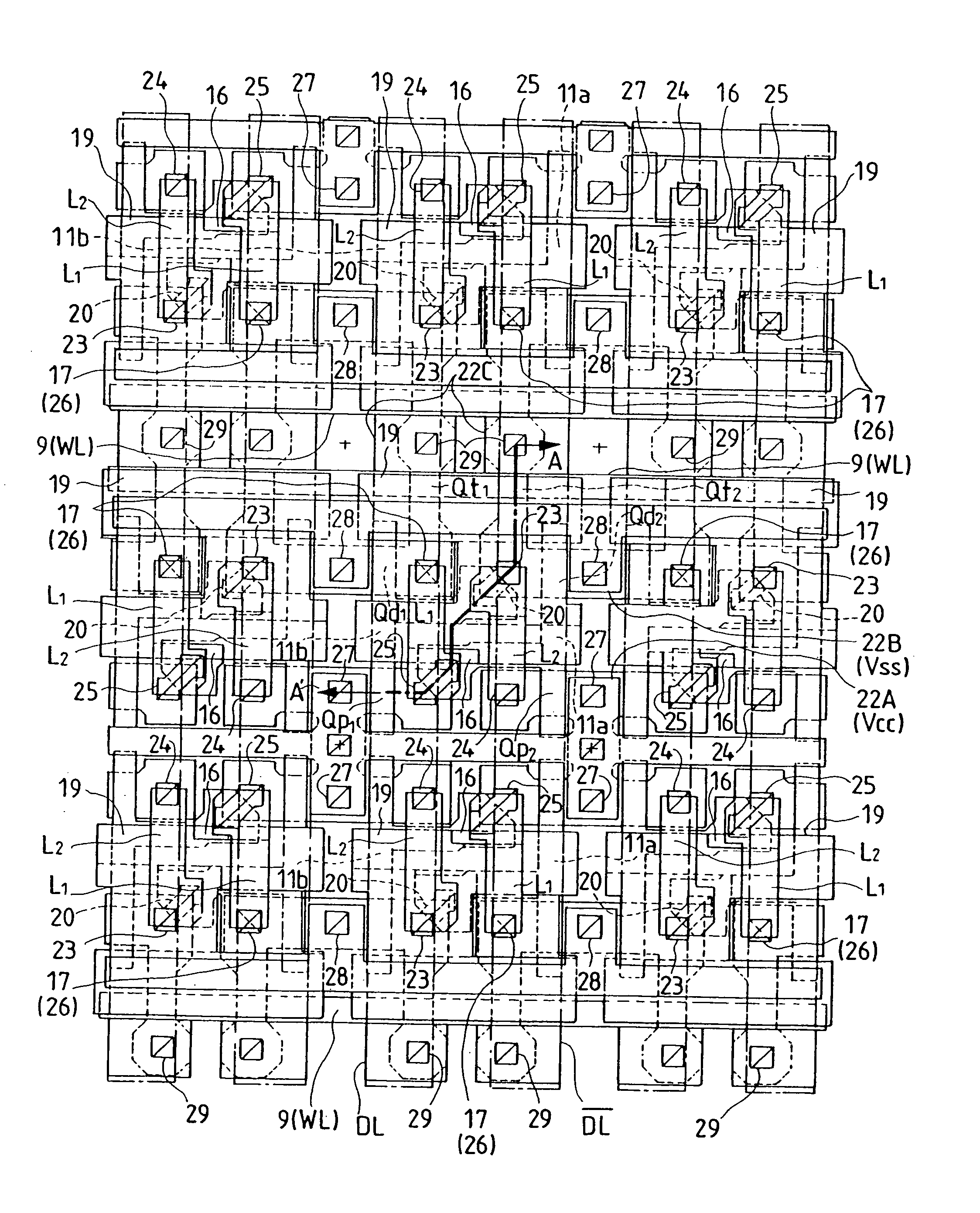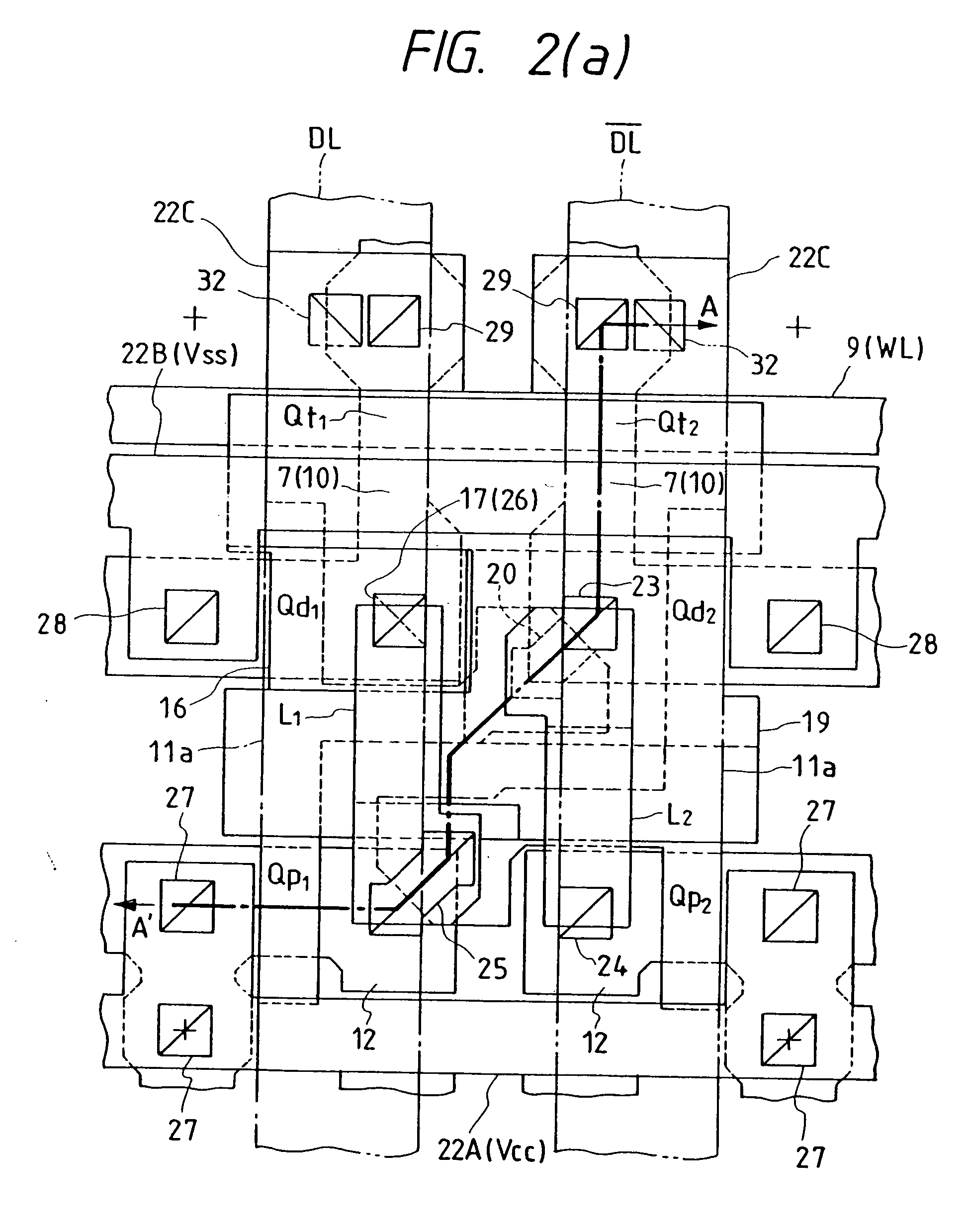Method of manufacturing semiconductor integrated circuit device having capacitor element
a technology of capacitor element and integrated circuit, which is applied in the direction of semiconductor/solid-state device details, digital storage, instruments, etc., can solve the problems of deteriorating soft error resistance, achieve the effect of improving the soft error resistance of memory cells, improving the degree of sram integration, and increasing the potential fluctuation of storage nodes
- Summary
- Abstract
- Description
- Claims
- Application Information
AI Technical Summary
Benefits of technology
Problems solved by technology
Method used
Image
Examples
embodiment 1
[0127]FIG. 4 is an equivalent circuit diagram of a memory cell of an SRAM of the present embodiment. As shown, this memory cell is constructed of a pair of driver MISFETs Qd1 and Qd2, a pair of load MISFETs Qp1 and Qp2 and a pair of transfer MISFETs Qt1 and Qt2, which are arranged at the intersections of a pair of complementary data lines (i.e., a data line DL and a data line / (bar) DL) and a word line WL. The driver MISFETs Qd1 and Qd2 and the transfer MISFETs Qt1 and Qt2 are of n-channel type, whereas the load MISFETs Qp1 and Qp2 are of p-channel type. In other words, the memory cell is of complete CMOS type using the four n-channel MISFETs and the two p-channel MISFETs.
[0128] Of the six MISFETs constituting the aforementioned memory cell, the paired driver MISFETs Qd1 and Qd2 and the paired load MISFETs Qp1 and Qp2 constitute together a flip-flop circuit serving as an information storage unit for storing information of 1 bit. One (storage node A) of the input / output terminals of ...
embodiment 2
[0169] A process for manufacturing the memory cells of the SRAM of the present embodiment will be described with reference to FIGS. 24 to 38. Incidentally, of the individual Figures showing the memory cell manufacturing process, the top plan views show only the conductive films and the contact holes but not the insulating films.
[0170]
[0171] First of all, as shown in FIG. 24, there are formed on the principal faces of the active regions of the p-type well 3 and the n-type well 4: the gate electrode 9 (the word line WL) of the transfer MISFETs Qt1 ant Qt2; the gate electrode 11a common to the load MISFET Qp1 and the driver MISFET Qd1; and the gate electrode 11b common to the load MISFET Qp2 and the driver MISFET Qd2. The steps up to this are identical to those of the foregoing Embodiment 1.
[0172] Next, in the present embodiment, the silicon oxide film 14 over the gate electrodes 11a and 11b is partially etched and thinned by using a photoresist as the mask. The portions thus tinned ...
embodiment 3
[0207] The process for manufacturing the memory cells of the SRAM of the present embodiment will be described with reference to FIGS. 40 to 52. Incidentally, of the individual Figures showing the memory cell manufacturing process, the top plan views show only the conductive films and the contact holes but not the insulating films.
[0208] First of all, as shown in FIG. 40, the first-level layer n-type polycrystalline silicon film is patterned to form the gate electrodes 9 (the word line WL) of the transfer MISFETs Qt1 and Qt2, the gate electrode 11a common to the load MISFET Qp1 and the driver MISFET Qd1, and the gate electrode 11b common to the load MISFET Qp2 and the driver MISFET Qd2 over the principal faces of the active regions of the p-type well 3 and the n-type well 4. Next, the silicon oxide 14 covering the gate electrodes 11a and 11b of the regions where the contact holes for connections of the local wiring lines set up in the later step are made is etched and thinned.
[0209...
PUM
 Login to View More
Login to View More Abstract
Description
Claims
Application Information
 Login to View More
Login to View More - R&D
- Intellectual Property
- Life Sciences
- Materials
- Tech Scout
- Unparalleled Data Quality
- Higher Quality Content
- 60% Fewer Hallucinations
Browse by: Latest US Patents, China's latest patents, Technical Efficacy Thesaurus, Application Domain, Technology Topic, Popular Technical Reports.
© 2025 PatSnap. All rights reserved.Legal|Privacy policy|Modern Slavery Act Transparency Statement|Sitemap|About US| Contact US: help@patsnap.com



